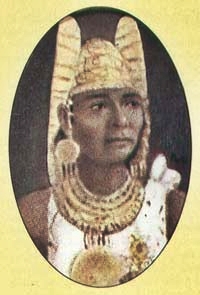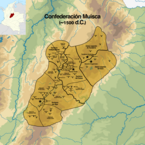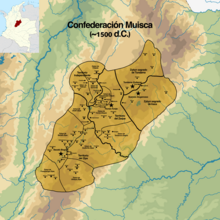Nemequene
| Nemequene | |||||
|---|---|---|---|---|---|
| Zipa of Bacatá | |||||
 Nemequene depicted in 1688 on the cover of Historia general de las conquistas del Nuevo Reyno de Granada by Juan de Castellanos | |||||
| Zipa of Bacatá | |||||
| Reign | c. 1490 – 1514 | ||||
| Predecessor | Saguamanchica | ||||
| Successor | Tisquesusa | ||||
| Nephew | Tisquesusa | ||||
| Born | unknown Bacatá, Muisca Confederation | ||||
| Died | 1514 Near modern Ventaquemada, Samacá, Hunza, Muisca Confederation | ||||
| |||||
| House | Bacatá | ||||
| Religion | Muisca religion | ||||
Nemequene or Nemeguene[1] (died 1514) was the third ruler (zipa) of Bacatá as of 1490. His zaque counterpart ruling over the northern area of the Muisca territory was Quemuenchatocha.
Etymology
Nemequene in the Chibcha language of the Muisca has two possible meanings, derived from the words nymy, "jaguar"[2] and quyne, meaning either "bone" or "force".[3]
Biography
Nemequene succeeded to the throne of the southern Muisca in 1490 after the death of his predecessor Saguamanchica in the Battle of Chocontá where the zaque of the northern Muisca Michuá had also died. While Nemequene wanted to continue the attacks against the northern Muisca, he had to face the dangers of the Panche to the west of his territory. Nemequene installed his nephew and legal successor Tisquesusa as army general to fight off the Panche with success.
Looking to expand the territory of the southern Muisca, Nemequene succeeded in the conquest of other areas in the central highlands of Colombia; the zipa defeated the cacique of Guatavita and submitted the cacicazgos of Ubaque, Ubaté, Susa and Fúquene to his rule.
At the end of his reign, Nemequene took up arms against the northern Muisca again, with Tisquesusa and his brother Sagipa as army commanders. Zaque Quemuenchatocha gained support of the caciques of Gámeza, Iraca, Tundama and Sáchica. The battle of the Arroyo de las Vueltas that followed lasted for half a day and just when Nemequene was about to claim victory, he was hit by an arrow by one of the guecha warriors of the northern Muisca and died five days later of his wounds. Sagipa, the later successor of Tisquesusa and last zipa of the Muisca ordered retreat. Tisquesusa succeeded his uncle as ruler of the southern Muisca until the arrival of the Spanish conquistadores led by Gonzalo Jiménez de Quesada.[4]

Code of Nemequene
To impose order, discipline and authority, Nemequene installed a cruel and excessive code. Based on the traditions and customs of the Muisca he ordered that in case of crimes against sexual honour (especially incest, rape and sodomy), property or the rule of the state short trials and fierce punishments would be installed. Part of the code was targeted at moral behaviour such as "don't lie" and "don't be lazy".[5]
If the defendant was unmarried, he was sentenced to death. In the case of being married, he would be dishonoured by forcing his wife to publicly live together with two men. Thieves were sentenced to be stabbed with burning sticks. Defaulting indebted Muisca were forbidden to use fire. Who had shown to be a coward in warfare was forced to wear women's clothes and perform the tasks of women. The ordinary Muisca were not allowed to wear expensive clothes or jewelry. Muisca men were forbidden to leave their wives and if she died doing labour the spouse was ordered to pay off her family.[5]
Bishop Lucas Fernández de Piedrahita wrote in the 17th century about the punishment against incest: "When a man committed incest with his mother, daughter, sister or niece, he would be thrown in a narrow pit filled with water where crawling bugs would be thrown in. The pit was covered with a slab and the victim died a horrible death."[5]
Nemequene in Muisca history
| History of the Muisca | |||||||||
| <timeline>
Preset = TimeHorizontal_AutoPlaceBars_UnitYear ImageSize = width:1250 barincrement:25 PlotArea = left:20 right:20 bottom:20 top:0 Define $bold = fontsize:M shift:(7,-1) Colors = id:canvas value:rgb(0.97,0.97,0.97) id:grid2 value:gray(0.88) id:lithic value:gray(0.8) id:ceramic value:rgb(0.95,0.9,0.6) id:mummy value:rgb(0.81,0.87,0.9) id:bochica value:rgb(0.9,0.7,0.8) id:art value:rgb(0.3,1,0) id:economy value:rgb(0.2,0.8,0.1) id:agriculture value:rgb(0.5,1,0) id:green value:rgb(0.5,1,0) id:muisca value:rgb(1,0.84,0) id:white value:gray(1) id:colonial value:gray(0) id:empire value:rgb(0.95,0.7,0) id:years value:gray(0.5) BackgroundColors = canvas:canvas Period = from:800 till:1570 ScaleMajor = unit:year increment:50 start:800 ScaleMinor = unit:year increment:10 start:1450 gridcolor:grid2 AlignBars = justify BarData= barset:culture barset:muisca barset:spanish barset:rulers barset:events bar:period PlotData =
width:15 fontsize:M textcolor:black align:left anchor:from shift:(3,-5) barset:culture from:800 till:1570 fontsize:L color:ceramic text:" Myths" align:left width:112 barset:muisca from:800 till:1540 fontsize:L color:muisca text:"Muisca Confederation" anchor:middle width:50 barset:spanish from:1539 till:1570 color:empire text:" Spanish Empire" align:left width:30 barset:rulers from:1448 till:1458 fontsize:L color:bochica text:"Tundama " align:left width:10 from:1520 till:1539 fontsize:M color:bochica text:"Tundama " align:left width:25 from:1448 till:1457 fontsize:L color:mummy text:"Suamox " align:left width:10 from:1435 till:1450 fontsize:M color:ceramic text:"Idacansás " align:left width:28 from:1500 till:1520 fontsize:M color:mummy text:"Nompanim " align:left width:10 from:1520 till:1537 fontsize:M color:mummy text:"Sugamuxi " align:left width:25 from:1438 till:1447 fontsize:M color:ceramic text:"El Dorado " align:left width:10 from:1420 till:1427 fontsize:M color:ceramic text:"Tota Monster " align:left width:10 from:1432 till:1437 fontsize:M color:ceramic text:"Goranchacha " align:left width:10 from:1510 till:1530 fontsize:M color:ceramic text:"Pacanchique " align:left width:10 from:1427 till:1437 fontsize:M color:ceramic text:"Thomagata " align:left width:10 from:1437 till:1447 fontsize:M color:ceramic text:"Tutazúa " align:left width:10 from:1448 till:1455 fontsize:L color:lithic text:"Hunza " align:left width:10 from:1450 till:1470 fontsize:M color:lithic text:"Hunzahúa " align:left width:10 from:1470 till:1490 fontsize:M color:lithic text:"Michuá " align:left width:15 from:1490 till:1537 fontsize:M color:lithic text:"Quemuenchatocha " align:left width:20 from:1537 till:1539 fontsize:M color:lithic text:" Aquiminzaque" align:left width:15 from:1420 till:1450 fontsize:L color:ceramic text:" Gods" align:left width:540 from:1536 till:1539 fontsize:L color:black text:" Conquest" align:left width:510 from:1420 till:1447 fontsize:S color:ceramic text:"Chiminigagua" align:left width:10 from:1422 till:1447 fontsize:M color:ceramic text:"Sué" align:left width:30 from:1424 till:1447 fontsize:M color:ceramic text:"Chía" align:left width:30 from:1426 till:1447 fontsize:M color:ceramic text:"Bochica" align:left width:10 from:1428 till:1437 fontsize:S color:ceramic text:"Chibchacum" align:left width:10 from:1430 till:1447 fontsize:S color:ceramic text:"Cuchavira" align:left width:10 from:1432 till:1447 fontsize:S color:ceramic text:"Chaquén" align:left width:10 from:1434 till:1447 fontsize:S color:ceramic text:"Huitaca" align:left width:10 from:1436 till:1447 fontsize:S color:ceramic text:"Nencatacoa" align:left width:10 from:1448 till:1455 fontsize:L color:green text:"Bacatá " align:left width:10 from:1450 till:1470 fontsize:M color:green text:"Meicuchuca " align:left width:10 from:1470 till:1490 fontsize:M color:green text:"Saguamanchica " align:left width:15 from:1490 till:1514 fontsize:M color:green text:"Nemequene " align:left width:15 from:1514 till:1537 fontsize:M color:green text:"Tisquesusa " align:left width:20 from:1537 till:1538 fontsize:M color:green text:" Sagipa" align:left width:15 barset:events from:1469 till:1470 fontsize:M color:colonial text:" Battle of Pasca" align:left width:10 from:1489 till:1490 fontsize:M color:colonial text:" Battle of Chocontá" align:left width:10 from:1537 till:1538 fontsize:M color:colonial text:" Battle of Tocarema" align:left width:10 from:1420 till:1450 fontsize:L color:ceramic text:" People" align:left width:330 from:1438 till:1440 fontsize:S color:ceramic text:"Lache " align:left width:10 from:1444 till:1447 fontsize:S color:ceramic text:"U'wa " align:left width:10 from:1431 till:1437 fontsize:S color:ceramic text:"Guane " align:left width:10 from:1423 till:1437 fontsize:S color:ceramic text:"Muzo " align:left width:10 from:1442 till:1447 fontsize:S color:ceramic text:"Achagua " align:left width:10 from:1430 till:1437 fontsize:L color:ceramic text:"Muisca " align:left width:10 from:1422 till:1437 fontsize:S color:ceramic text:"Panche " align:left width:10 from:1440 till:1447 fontsize:S color:ceramic text:"Tegua " align:left width:10 from:1433 till:1439 fontsize:S color:ceramic text:"Guayupe " align:left width:10 from:1425 till:1437 fontsize:S color:ceramic text:"Sutagao " align:left width:10 </timeline> | |||||||||
 Altiplano |
 Muisca |
 Art |
 Architecture |
 Astronomy |
 Cuisine |
 El Dorado |
 Subsistence |
 Women |
 Conquest |
Trivia
- Nemocón, the second most important salt mining settlement of the Muisca, is named after Nemequene[6]
See also
Lua error in mw.title.lua at line 346: bad argument #2 to 'title.new' (unrecognized namespace name 'Portal').
References
- ^ As shown on the seal
- ^ (in Spanish) Muisca dictionary - nymy
- ^ (in Spanish) Muisca dictionary - quyne
- ^ (in Spanish) History of the Muisca - Banco de la República
- ^ 5.0 5.1 5.2 (in Spanish) Biography Nemequene and Nemequene Code - Pueblos Originarios
- ^ Espejo Olaya, 1999, p.1121
Bibliography
- Espejo Olaya, Maria Bernarda (1999), Notas sobre toponimia en algunas coplas colombianas - Notes about toponomy of some Colombian ballads - Thesaurus (PDF) (in español), vol. Tomo LIV, Núm. 3., pp. 1102–1157, retrieved 2016-07-08
